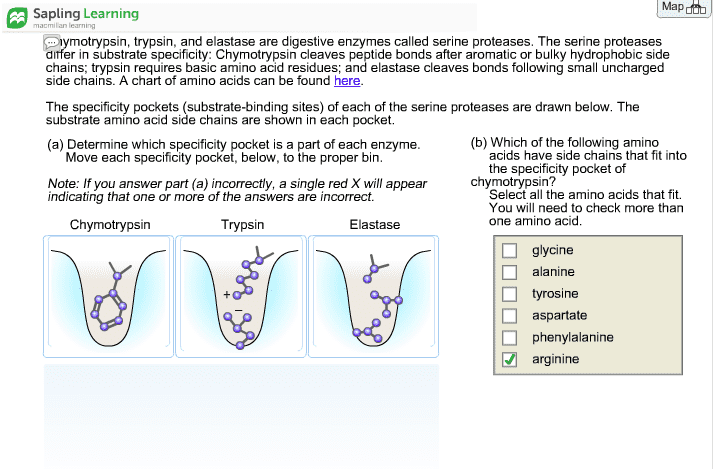CHE 211 Study Guide - Final Guide: Divergent Evolution, Phenylalanine, Amylase

Organic Chemistry 2: Enzymes
Proteolytic Enzymes
► Proteolytic enzymes cleave the peptide bond in proteins (hydrolyze
the peptide bonds between amino acids in a protein chain)
- These enzymes break the peptide bonds that maintain the
primary protein structure
- These ezyes’ specificity deped o a
hydrophobic pocket
- A cluster of hydrophobic amino acids brought together by the 3-D folding
of the protein chain
► Chymotrypsin (example of a proteolytic enzyme) cleaves the peptide
bond at the carboxylic end of these amino acids:
o Methionine
o Tyrosine
o Tryptophan
o Phenylalanine
► The specificity of the enzyme depends on the presence of the
hydrophobic pocket
► On the left, you can see the hydrophobic pocket of chymotrypsin, which holds the
aromatic side chains of the substrates this brings the peptide bond to be cleaved at
the catalytic domain of the active site
Proteolytic Enzymes and Evolution
Pancreatic serine proteases are a category of enzymes which all hydrolyze peptide
bonds of chymotrypsin, trypsin and elastase
They appear to have arisen through divergent evolution from a common ancestor
Similar primary structures
Similar tertiary structures
Different specificities
Each enzyme has a different pocket to fit the specificity for the side chains of their
substrates (different keys fit different locks)
o Chymotrypsin: cleaves peptide bonds on the carbonyl side of aromatic amino
acids and large, hydrophobic amino acids
o Trypsin: cleaves on the carbonyl side of basic amino acids
o Elastase: cleaves on the carbonyl side of Gly and Ala
o These proteolytic enzymes are produced in the pancreas and are transported to
the small intestine
find more resources at oneclass.com
find more resources at oneclass.com
Document Summary
Proteolytic enzymes cleave the peptide bond in proteins (hydrolyze the peptide bonds between amino acids in a protein chain) These enzymes break the peptide bonds that maintain the primary protein structure. These e(cid:374)zy(cid:373)es" specificity depe(cid:374)d o(cid:374) a hydrophobic pocket. A cluster of hydrophobic amino acids brought together by the 3-d folding of the protein chain. Chymotrypsin (example of a proteolytic enzyme) cleaves the peptide bond at the carboxylic end of these amino acids: methionine, tyrosine, tryptophan, phenylalanine. The specificity of the enzyme depends on the presence of the hydrophobic pocket. On the left, you can see the hydrophobic pocket of chymotrypsin, which holds the aromatic side chains of the substrates this brings the peptide bond to be cleaved at the catalytic domain of the active site. Pancreatic serine proteases are a category of enzymes which all hydrolyze peptide bonds of chymotrypsin, trypsin and elastase. They appear to have arisen through divergent evolution from a common ancestor.


